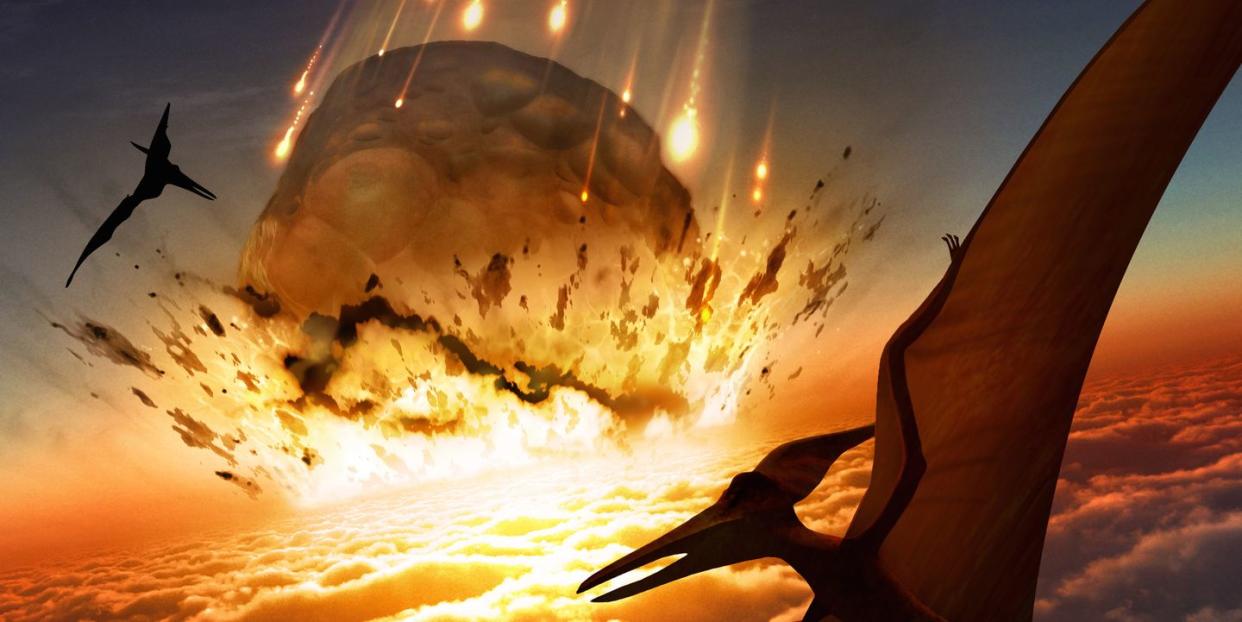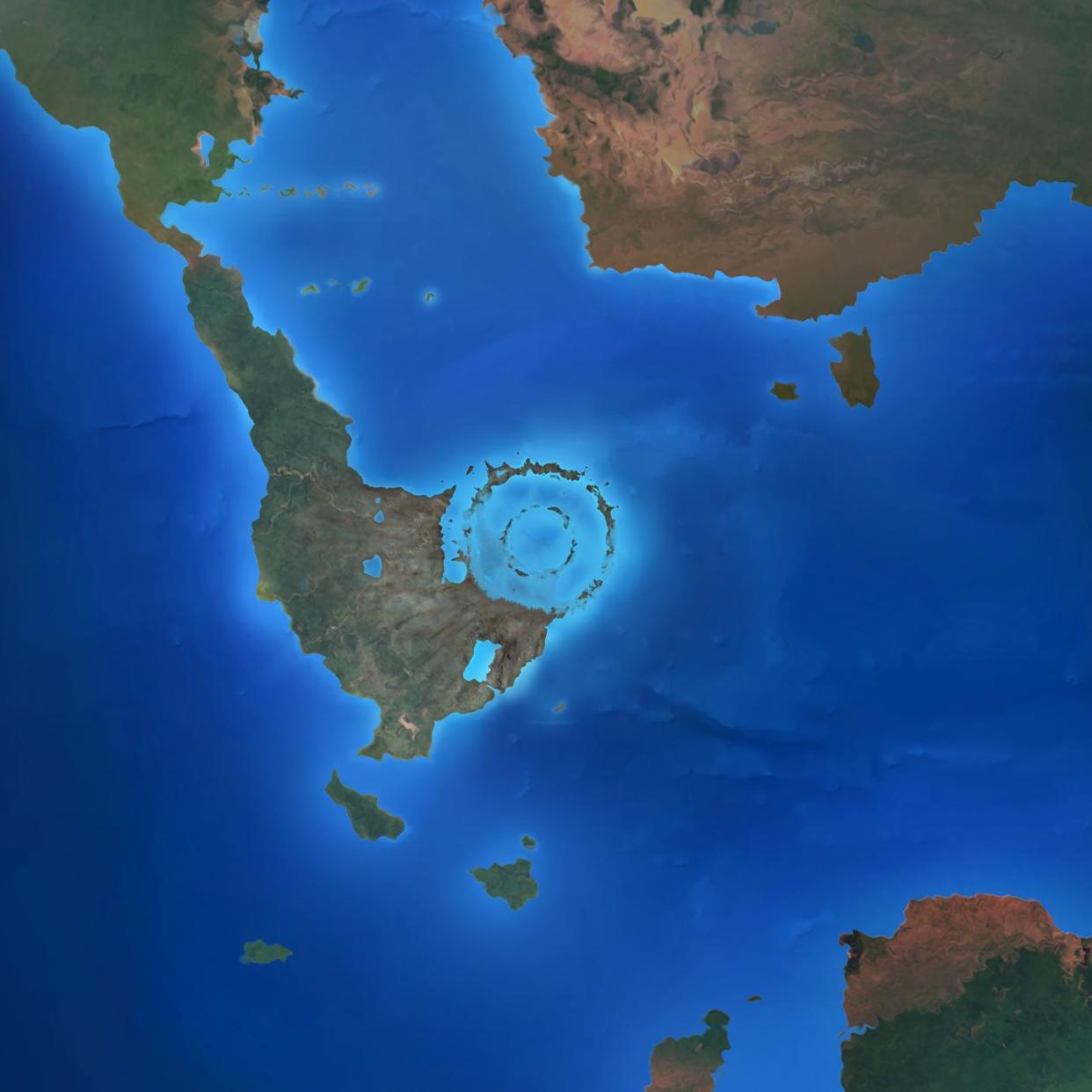TWO Asteroids May Have Killed Off the Dinosaurs, Scientists Say

A newly-discovered crater 250 miles off the coast of West Africa could have been formed by a large asteroid strike.
The probable timing of this potential asteroid strike could make it a “sibling” of the dinosaur-killing Chicxulub asteroid hit.
Researchers hope to investigate the crater to gain more precise clues into the timing of the likely impact.
Scientists have long believed the Chicxulub asteroid smacked Earth near the Gulf of Mexico, causing about a 100-million-megaton blast devastating enough to erase the dinosaurs from Earth. That burst created a short-lived thermal pulse in excess of 10,000 degrees, which is certainly lethal enough to have destroyed nearby life. But the massive asteroid may have had some help from a second “sibling” asteroid, scientists say.
More than five miles in diameter beneath the North Atlantic Ocean, the newly-discovered Nadir Crater lies about 250 miles off the coast of West Africa—and researchers believe that the asteroid that may have caused it about 66 million years ago could have been that dino-killing helper. There are two prevailing theories about this second asteroid, according to a new study, published August 17 in Science Advances: that the asteroid may have been a broken-off piece of the Chicxulub asteroid, or that it was a wholly separate asteroid from an impact cluster.
🦕 You love dinos. So do we. Let’s nerd out over them together—join Pop Mech Pro.
Led by Veronica Bray, a research scientist at the University of Arizona Lunar and Planetary Laboratory, the new work includes simulations that show the collision that formed the Nadir Crater was powerful enough to cause at least widespread local disruption.
“This would have generated a tsunami over 3,000 feet high, as well as an earthquake of more than magnitude 6.5,” she says in a university press release. “Although it is a lot smaller than the global cataclysm of the Chicxulub impact, Nadir will have contributed significantly to the local devastation. And if we have found one ‘sibling’ to Chicxulub, it opens the question: Are there others?”
Geologist Uisdean Nicholson of Heriot-Watt University in Edinburgh, and a co-author of new the paper, found the crater—which is still not confirmed as an asteroid-caused depression—and he wasn’t even looking for it. While examining seismic reflection data from the seabed, related to a research project detailing seafloor spreading, he found something that intrigued him.
“I’ve interpreted lots of seismic data in my time, but had never seen anything like this,” he says in the release. “It has particular features that point to a meteor impact crater. It has a raised rim and a very prominent central uplift, which is consistent for large impact craters.” Nicholson says chaotic sedimentary deposits extend for tens of miles outside the crater and the characteristics are not consistent with other crater-forming processes, such as salt withdrawal or volcano collapse.
Bray says the timing of the asteroid impact that caused the Nadir Crater could have been around the same time as the Chicxulub asteroid impact. This potential asteroid could have been from a breakup of a parent asteroid, like Chicxulub itself, or it could have originated from a swarm of asteroids around that same time. If confirmed, the Nadir Crater will be one of less than 20 marine impact craters found on Earth. Nicholson has applied for funding to drill the seabed to confirm the asteroid impact and test its age.

The potential for life-altering repercussions from Nadir are plainly evident. Bray says the energy released from the impact would have been 1,000 times greater than the tsunami caused by the underwater eruption of the Tonga volcano in January. “These are preliminary simulations and need to be refined when we get more data,” Bray says, “but they provide important new insights into the possible ocean depths in this area at the time of impact.”
Co-author Sean Gulick, an impact expert at the University of Texas at Austin, gets drawn to the potential meaning this may have had on our long-lost dinosaurs. “The Nadir Crater is an incredibly exciting discovery of a second impact close in time to the Cretaceous-Paleogene extinction,” he says in the release. “While much smaller than the extinction causing Chicxulub impactor, its very existence requires us to investigate the possibility of an impact cluster in the latest Cretaceous.”
The researchers place the crater in the same era because of the sediment boundaries, although the early stages of data-gathering do limit the potential for a more precise timing of the impact. “Despite four billion years of impactors hitting Earth, only 200 have been discovered,” Gulick says. “It is thus exciting news whenever a new potential impact is discovered, especially in the hard-to-explore marine environment.”
You Might Also Like
